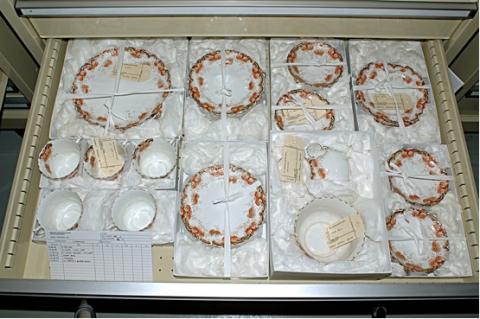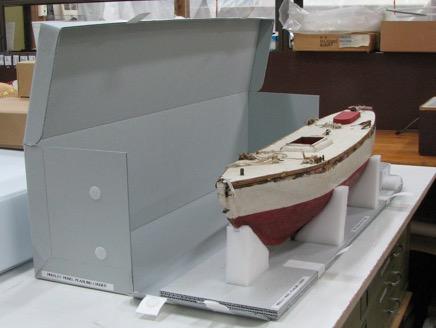Boxes
Storing objects in boxes is generally good practice. A box forms a further buffer to ambient conditions, restricts the movement of an object and protects it from light, insects and dust. As it encapsulates an object, a microclimate will be established within a box. It is important therefore that the box itself and any packing materials used inside it are compatible with the materials from which the object is constructed and will not cause damage to the object in the long term (see Packing for Storage below).
Recycling corrugated cardboard cartons for the storage of museum objects is not recommended and it is a definite ‘no no’ if they have previously contained food. As corrugated cardboard is made of wood pulp it is acidic and the corrugations are perfect habitats for insects. In addition the folds on the bottom of a carton provide an uneven base which may compromise object safety. Solid cardboard walled boxes can be used but not if they have contained food as any remnants will attract insects.
Storage box systems for specific sensitive types of material such as textiles, paper and photographs are described elsewhere (see the relevant chapters).
Types of Boxes
There is a range of boxes that are useful for object storage:
- Modular specimen trays – base with no lid;
- Modular brown cardboard boxes – base and separate lid;
- Modular polypropylene boxes – base and separate lid;
- Conservation suppliers’ standard boxes – base and separate or hinged lid; and
- Custom hand made boxes – diverse designs.
Modular Specimen Trays
Modular specimen trays are custom made to fit the drawers of metal storage cupboards (Figure 6). These are made of non-archival card covered with archival paper. The build up of acidity in these trays is minimal because they are not lidded. Sizes are designed to configure within the drawer and could be a half, quarter, eighth or sixteenth of the drawer sizes. These trays allow objects to be secured within the drawer and therefore not suffer damage when the drawer is opened or closed, objects can be viewed without handling and can be moved by lifting the tray.
Figure 6: BAC™ drawers fitted with modular specimen trays.
(a) The china is held in place with small balls of tissue and cotton tape ties
(b) The objects are tied down to a Cell-Aire® base (images courtesy Jon Carpenter, WA Museum).
Modular Brown Cardboard Boxes
Modular brown cardboard boxes can be custom made for shelf storage (Figure 2). These are not archival and are most suitable for storing objects that are non-sensitive. However many small institutions are only able to afford this type of box. These boxes can still provide a durable and safe environment if a solid low acidic card is chosen, boxes are ventilated and when appropriate, lined with acid-free tissue or barrier paper to reduce acid migration (see Packing for Storage below).
Choose and configure the modular boxes so that the best use is made of the available space on the shelving without compromising the ability to remove box lids easily and without making the boxes too big and too heavy for easy handling. When having boxes made, check whether the manufacturer works using inside or outside dimensions and ensure that lids are about 100 to 150 mm deep. Damage can be done if it is difficult to remove a deep lid from a base.
Modular Polypropylene Boxes
Conservation suppliers will custom make modular polypropylene boxes (Figure 2). This is only cost effective if boxes are bought on a large scale as each differently sized box requires a template to be prepared, adding to the overall cost of the order. However, a carefully designed modular system can utilise all storage space on a shelf and therefore save money in the long term. As mentioned above, configure the boxes so that the best use is made of all available space without compromising either the artefacts or the ease of handling them.
Conservation Suppliers’ Standard Boxes
Conservation suppliers have standard boxes available made using archival multi-purpose board and polypropylene. It is prudent to include these standard box sizes in the equation when designing the best shelving configuration for a store.
Custom Handmade Boxes
It is most time efficient to use pre-made boxes even if fitting of additional components is required. Some objects will however, require custom hand-made boxes of archival multi-purpose board. While polypropylene flute board and Fomecore™ can be used for box making they require reinforcing along the joins. Archival multi-purpose boards are available in either single or double thicknesses, with the format and weight of the object to be stored determining which of these will be most appropriate for specific objects. There are templates available for different types of box making but some standard formulae and templates are
- base and separate lid with adhered joins;
- base and separate lid with folded construction;
- base with hinged lid with adhered joins;
- base with hinged lid and hinged front flap with adhered joins; and
- base with hinged front flap and separate lid with folded construction (Figure 7).
Figure 7: Custom hand-made box of archival multi-purpose corrugated board with hinged front flap and separate lid. The sponge is mounted on Cell-Aire® covered Ethafoam™ 220 supports mounted on a removable tray (image courtesy Carmela Corvaia, WA Museum).
The construction of custom hand-made boxes varies depending on the box design. There are designs where the construction is secured by folding, with tabs fitting into slots rather than using adhesives. Thinner boards such as single multi-purpose archival corrugated board are best for these types of boxes. Other constructions might require the use of hot glue, adhesives and tapes to construct the box. All have a flat piece of board as the base, unlike a carton which has four flaps folded in.
Some boxes can be cut out of one piece of board while others of larger format require stock board to be joined. Corner joins or joining stock board together can be done by neatly paring back about 40 mm of board to the outer card and adhering the overlapping card to the board. Ensure the construction technique is adequate for the weight of the object being stored. An additional base board greatly strengthens a box structure and can be used as a base on which supports can be adhered (Figure 8). Tyvek® tape can be used to make tabs for closures with Velcro self-adhesive dots if required.
Figure 8: Custom made box of archival multi-purpose corrugated board with hinged front flap and lid. The corners are adhered together. The model boat sits on a Cell-Aire® covered Ethafoam™ 220 cradle on a removable tray (image courtesy Maggie Myers, WA Museum).




